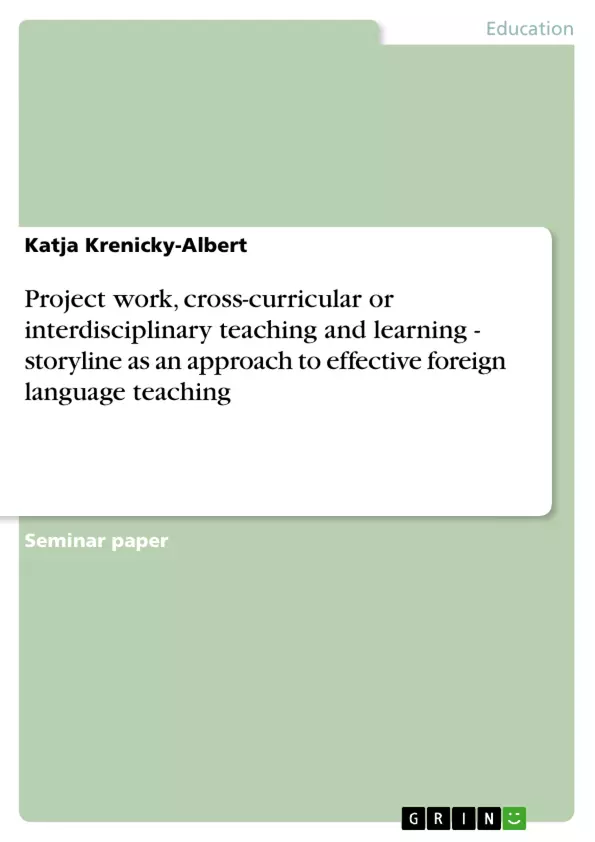Project work, cross-curricular or interdisciplinary teaching and learning, openplanned lessons, experiential learning - these are only a few of the whole range of existing terms expressing a trend of educational methodology postulated by theorists throughout many past decades. Related to each other by the similar notion of ‘learning by doing’ they intended to reform the antiquated style of traditional teaching and replace it by a methodology characterised by learner orientation and learner autonomy. Due to the rapidly changing world and its demands the fact-based education system had to move to a skilled-based conception characterised by process- rather than content-orientation.
The lack of practical translation of constructivist ideas in (foreign language) teaching, decisive findings in cognitive psychology, constructivist philosophies as well as many students’ and teachers’ experiences have proved the positive impact of project work and openplanned teaching on effective and successful (language) learning. One of them, the Storyline concept, is the central subject of this work - a more general theoretical reflection - which is followed by a concrete design of a Storyline unit for the primary English classroom.
Inhaltsverzeichnis (Table of Contents)
- Introduction
- What is Storyline?
- The Origins
- The Conception
- Main Features
- Historical Precursors and Theoretical Foundations of Storyline
- Historical Background and Origins of Project Work
- Main Differences between Storyline and Project Work
- The Story
- The Identification with the Characters
- Key Questions
- Cognitive and Developmental Psychology
- Constructivism
- Second Language Acquisition Research
- Storyline as an Approach to Effective Foreign Language Teaching - Strengths and Weaknesses
- The narrative principle
- Relation to Real Life
- Authentic Communication
- Holistic Learning
- Product-Orientation
- Skill-Based and Process-Oriented Learning
- Learner-Orientation
- Developing Learner Autonomy
- Interdisciplinary Learning
- Role of the Teacher
- Assessment and Evaluation
- Relation of Storyline to Other Teaching Methods and Commercial Materials
- Storyline in the Primary Foreign Language Classroom
- Strengths and Advantages
- Weaknesses, Disadvantages and Problems
- Conclusion: Challenges, Chances and Prospects of Storyline as an Approach to Primary Foreign Language Teaching
Zielsetzung und Themenschwerpunkte (Objectives and Key Themes)
The primary goal of this work is to explore the Storyline concept, a project-based approach to foreign language teaching, and examine its efficacy and applicability in a primary English classroom. The work examines the theoretical foundations of Storyline, including its historical precursors, constructivist pedagogy, and findings from cognitive and developmental psychology. It then delves into the specific strengths and weaknesses of Storyline as a teaching method, exploring its impact on learner autonomy, interdisciplinary learning, and the role of the teacher.
- The origins and development of the Storyline concept.
- The theoretical underpinnings of Storyline, including constructivist and reform-pedagogical ideas.
- The strengths and weaknesses of Storyline as a teaching method in the context of foreign language learning.
- The potential challenges and opportunities of implementing Storyline in primary English language classrooms.
- The role of the teacher and the importance of learner autonomy in a Storyline-based learning environment.
Zusammenfassung der Kapitel (Chapter Summaries)
- Chapter 1: Introduction
This chapter introduces the concept of Storyline as an innovative approach to foreign language teaching. It discusses the shift from traditional, content-oriented teaching to a more skilled-based approach that emphasizes learner autonomy and 'learning by doing'. The chapter highlights the need for students to develop skills in information gathering, communication, problem-solving, and independent learning.
- Chapter 2: What is Storyline?
This chapter provides a definition of the Storyline concept, outlining its origins and conception. It highlights the main features of Storyline, such as its narrative structure, its emphasis on learner engagement, and its integration of different learning activities.
- Chapter 3: Historical Precursors and Theoretical Foundations of Storyline
This chapter explores the historical and theoretical foundations of Storyline, tracing its roots to project work and constructivist pedagogy. It examines key differences between Storyline and traditional project work, highlighting the role of story, character identification, and open-ended questions in Storyline. The chapter also considers the contributions of cognitive and developmental psychology to understanding the learning process and the relevance of these theories to Storyline.
- Chapter 4: Storyline as an Approach to Effective Foreign Language Teaching - Strengths and Weaknesses
This chapter examines the potential of Storyline to meet the requirements of effective foreign language teaching. It explores various strengths of Storyline, including its narrative principle, its connection to real-life situations, its promotion of authentic communication, its holistic approach to learning, and its emphasis on learner-orientation and autonomy.
- Chapter 5: Storyline in the Primary Foreign Language Classroom
This chapter focuses on the practical application of Storyline in primary English language classrooms. It discusses the strengths and advantages of using Storyline in this context, as well as potential weaknesses, disadvantages, and challenges. The chapter also examines the prospects of Storyline for effective primary foreign language teaching.
Schlüsselwörter (Keywords)
The primary keywords and focus topics of this work include: Storyline, foreign language teaching, project work, constructivism, learner autonomy, interdisciplinary learning, authentic communication, narrative principle, primary English language classroom, strengths and weaknesses, challenges and opportunities.
- Quote paper
- Katja Krenicky-Albert (Author), 2004, Project work, cross-curricular or interdisciplinary teaching and learning - storyline as an approach to effective foreign language teaching, Munich, GRIN Verlag, https://www.grin.com/document/43973



